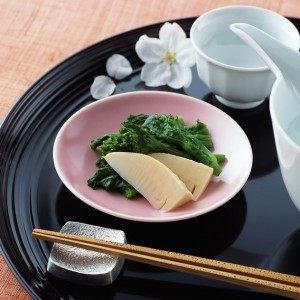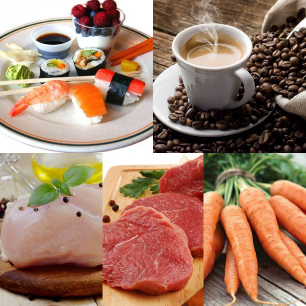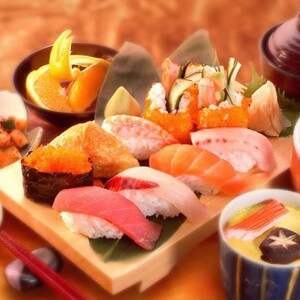
The Japanese diet is a low carb and low calorie diet developed by Japanese nutritionists, whose protein menu allows you to lose about 10 pounds in 2 weeks.
Being overweight today many people are asking for payment for an incredibly fast lifestyle. We rush to live, we rush to work, we rush to eat. . . In addition, we often eat on the run and with that, as they say, God will send. And in the 21st century, God is sending us more and more hamburgers, hot dogs, cheeseburgers and soda. . . "What to do; Do not miss precious minutes for lunch in a restaurant or what? ! - to cook alone in the kitchen when business is "fire"? Here, they say, the whole successful world lives like that and nothing. "This excuse is used by a lot of people who follow an active lifestyle. And when your favorite jeans do not fit, when you have to buy a bigger belt, when between a seductive skirt that fits tightly in the middle and an ugly amorphous style withan elastic band, we choose the second, then, of course, it's time to find a new excuse. Well, in fact - all this, of course, is not the result of improper diet, but simply . . . of a fat bone. Yes, yes, and there is nothing to be done about it, a thick bone - it's so, so insidious. And once it starts to grow - everything, it 's impossible to stop it.
Now let us turn our attention to Japan, a country with enormous opportunities, the highest level of technological development and an incredible pace of life. It seems that if one does not have time to stop for the right meals, it is like the Japanese. But, surprisingly, you rarely come across "thick bones" among the people of Japan. . . So what's the secret?
The fact is that Japanese snacks are low-calorie, high-protein, low-fat, low-carbohydrate foods. And the basic principle of the Eastern food tradition is moderation. This is why Japanese cuisine is called one of the healthiest foods for the body.
Taking into account the peculiarities of the eastern tradition of the diet, a balanced and highly effective diet was created called Japanese. In fact, there is almost no traditional Japanese cuisine on the menu of this diet. But there is more protein, fat and carbohydrates in the amount needed just to get what the body needs without causing the bones to "thicken" at the same time. There are many dietary options, but the most popular is the Japanese salt-free diet for 14 days. Two weeks of proper "Japanese" diet will help "fat bones" lose more than 10 kg and you can easily maintain the result for several years.
The essence of the Japanese diet
Those who decide to go "Japanese" should be patient and stay away from their usual way of eating for two weeks. For many, dieting may seem like a daunting task, but the result will not be long in coming. But the amazing results will remain for many years. Only a two-week regime of the "Japanese woman" - and ten kilos (sometimes even more - it all depends on the initial weight), as it were.
So what is the main secret? Why is a Japanese diet for a week better than other weight loss diets? In what wonderful way does it help to lose weight even for those who have tried many other diets on their own?
These are carefully selected products for the diet menu - they are combined in such a way as to speed up the metabolic process as much as possible. Therefore, it is so important to strictly follow all the instructions, to eat only the indications, not to "improve" its other products, even if at first glance it seems that they are completely interchangeable. Also, alternating menu days is not recommended.
For many women, when choosing their diet, the level of "hunger" is important, as not everyone is able to fight with the will of the samurai against their desires, especially the very old instinct of all living beings -hunger. For the fact that the Japanese diet without salt for two weeks is not a "hungry" diet. By keeping it, you will not have to chew a cabbage for weeks and drink low-fat kefir, cursing yourself, your overweight and those who have gone on a diet. The menu of the Japanese woman contains a place for interesting and delicious recipes. This diet will be especially aimed at those whose breakfast usually consists of only coffee. And meat and fish lovers will not see anything difficult in this. This is the best diet for them.
The essence of the Japanese diet is easy to explain in two words - slowness and efficiency.
"Japanese" is a diet low in calories in protein and fiber. Carbohydrates, reduced to a minimum in the daily diet, force you to lose weight faster - in need of energy, the body begins to process its own fat stores in joules. But it is important to remember something else: The diet of a Japanese woman will not allow the body to be saturated with the full range of vitamins and minerals. Therefore, it is strictly forbidden to diet more than planned (not more than 14 days), so as not to complete a course of weight loss in a hospital bed.
And if you want to feel like a real Japanese, you can try Japanese sticks instead of forks and spoons traditional for Europeans. They will not only transmit the wonderful spirit of the Land of the Rising Sun, but will also teach you how to eat slowly and in small chunks. By the way, this trick is known to many diet advocates. A relaxed meal can fool the body and make you feel full even after very small meals. This, in fact, should be taught by the Japanese dieters for weight loss.

Types of Japanese Diet
The immense popularity of the Japanese diet among women around the world has led to the emergence of many options for this weight loss system. In particular, dietary options are known:
- Japanese diet without salt for 7 days?
- for 13 days (the most commonly used diet).
- for 14 days (differs from the previous 13-day diet, only one day).
- Japanese woman with green tea?
- The diet of Naomi Moriyama.
The menu of the Japanese diet for weight loss consists of foods low in calories, carbohydrates and without salt, spices, sugar and pastries, as well as any alcohol, so the diet is considered strict. This contributes to the rapid breakdown of fat into body fat, as the body is in a state of stress and is forced to burn its fat and calories.
Diet menu for 7 days
The 7-day Japanese diet is a light version of the traditional Japanese diet, but at the same time, the 7-day diet is the basis of the whole diet.

Predicted results: 3-5 kg left in the past.
Disadvantage: the longevity of the result is not guaranteed, as the body has not yet had time to adapt to the new metabolic system.Day 1
Calorie content of the daily diet: 700 kcal.
Required products:
- black coffee?
- chicken eggs?
- fresh cabbage (Beijing cabbage / white cabbage);
- tomato juice (ideally fresh)
- low fat fish.
Breakfast:
- black coffee - it is better to prefer espresso, but it is better to forget about sugar.
Lunch:
- boiled chicken eggs (2 pieces are possible).
- "Japanese" salad - fresh cabbage and a little vegetable oil, no need to add salt
- a glass of tomato juice.
Dinner:
- steamed fish - cod cod, cod, cod is ideal (portion not more than 200 grams).
- Japanese salad.
Day 2
Calorie content of the daily diet: 1000 kcal.
Required products:
- coffee?
- nuts?
- fish (fatty varieties);
- cabbage?
- vegetable oil?
- beef?
- kefir.
Breakfast:
- coffee?
- nuts - take a small one, weighing about 30 grams.
Lunch:
- fish, fried or stewed - for variety and extra consumption of fatty acids, it is better to prefer catfish, salmon, black halibut. In total, no more than 150 grams.
- "Japanese" salad.
Dinner:
- beef - boil about 200 grams. Consume without salt.
- kefir - you can avoid, but not more than a 200 gram glass.
Day 3
Calorie content of the daily diet: 1000 kcal.
Required products:
- coffee?
- zucchini / parsnip;
- apple?
- chicken eggs?
- calf?
- cabbage?
- vegetable oil.
Breakfast:
- black coffee - do not forget the sugar moratorium.
Lunch:
- zucchini (large enough) or parsnip root (also large) - brown in vegetable oil (do not use flour or batter for frying, salt is also prohibited).
- apple - do not get carried away, it is recommended to limit yourself to one fruit.
Dinner:
- boiled chicken eggs - 2 pieces.
- boiled beef - limit your appetite to a 200 gram piece prepared without salt.
- "Japanese" salad.
Day 4
Calorie content of the daily diet: 1000 kcal.
Required products:
- coffee?
- carrot?
- hard cheese?
- chicken egg?
- apples.
Breakfast:
- black coffee without sugar.
Lunch:
- carrots - boil, allowed to take 3 larger roots.
- a little cheese - choose from hard varieties, limit yourself to 20 grams.
- raw chicken egg - one is enough.
All the ingredients of a 4 day meal, if you want, can be combined in a single dish - salad.
Dinner:
- apples - many fruits are allowed.
At this point, the feeling of hunger will no longer be as strong as before. Fullness comes after small portions of food.
Day 5
Calorie content of the daily diet: 800-1000 kcal.
Required products:
- carrots?
- lemon juice?
- sea fish?
- juice?
- fruit.
Breakfast:
- carrots and lemon juice - grate the vegetable and flavor with juice. You can not add sugar. It is also excluded this day from breakfast and coffee.
Lunch:
- fried fish - take about 350-400 grams, variety - any from the sea.
- tomato juice - for a diet, it would be better to use fresh, prepared yourself Volume - no more than 200 grams.
Dinner:
- fruit - but under no circumstances should you eat grapes of any variety or bananas, especially before bed. They will surpass all the results achieved so far.
Day 6
Calorie content of the daily diet: 900-1100 kcal.
Required products:
- coffee?
- chicken fillet?
- raw cabbage?
- carrots?
- vegetable oil?
- chicken eggs.
Breakfast:
- black coffee without sugar.
Lunch:
- chicken fillet - limit portion to 500 g, get skinless meat. Boil in water without adding salt.
- salad - these days, a traditional "Japanese" salad can be enhanced by adding grated raw carrots.
Dinner:
- chicken eggs - boil 2 pieces.
- carrots (you can get a large one) - grate a raw vegetable, season the salad with a small amount of vegetable oil (maybe olive oil).
Day 7
Calorie content of the daily diet: 700-800 kcal.
Required products:
- tea;
- fruit?
- beef?
- eggs?
- cabbage?
- vegetable oil.
Breakfast:
- tea - it is recommended to choose good varieties of green, rich in beneficial antioxidants.
Lunch:
- beef - boil about 200 grams. Do not use salt or other spices when cooking.
- fruit - on the last day of the diet, you can enjoy a dessert for lunch. But do not forget to ban the use of bananas and grapes.
Dinner:
On this day for dinner, as a reward for endurance, you can choose any dinner option from the previous days. For example, choose a version of beef, eggs and cabbage salad seasoned with olive oil.
This will end the diet for some. For those who have chosen the larger versions of the Japanese woman, the 7th day is just the equator of work to change oneself.
For those who are not used to eating calories, "Japanese" at first may seem like a rather difficult choice for weight loss. But the discomfort will be felt only for the first few days - then the body adjusts to small portions of food, begins to eat faster. After 5 days of a new diet in the body, the first stage of restructuring begins to speed up the metabolism - the main goal of any diet is to lose excess weight, excess fluid is removed, the swelling disappears. To achieve the best result along with a diet, you can do an anti-cellulite massage.
Japanese diet for 13 days
The 13-day Japanese diet is the most popular. This version is considered a complete weight loss course.
Predicted results. If you are ashamed to follow all the recipes, at the end of the 13-day, you will lose about 10 pounds and about 30 inches in volume (sometimes more).
How is it different from the 7 day option? In fact, it's a sequel to the lightweight version of The Japanese Woman. That is, you have to go through 7 days of "Japanese" life, and the 8th day starts again from the beginning, repeating days from the first to the sixth.

Japanese diet for 14 days
The basis for the 14-day version of the Japanese diet was also the 7-day menu, albeit with some nuances. The main difference from the two previous options is that in the first week you have to strictly follow the 7-day menu and in the second week for food according to the same program, but in the opposite order. This means that the diet of the eighth day will correspond to the diet of the last day of 7 days, the ninth day - the menu of the 6th day, the tenth - the menu of the 5th day. . . And according to this principle, continue until the end of the second week. As a result, complete the last 14 days of the diet with the diet of the first day of the 7-day version of the "Japanese woman".
Starting from the 8th day of the diet, the detoxification process is activated in the body and due to the principle of a salt-free diet, the excess fluid is removed at the cellular level, completely eliminating the swelling. It is important that in the second week of the diet the body gets used to the new metabolic rate. Thanks to this, even after switching to a normal diet (usually - this does not mean eating again in the basins for the next sleep, but also you do not need to live in a state of "hunger") the body will not gain weight, on the contrary -fat will burn as fast as during the diet. This wonderful result will last for about 2 years. But provided the diet was maintained properly. Those who have already experienced the work of a "Japanese woman" claim that for a year after completing the diet, the weight continues to adjust downwards. If you repeat the "Japanese woman" again (but not earlier than six months after the first course), then in a year, practically without effort, it is really possible to get rid of 20 pounds of excess weight.
Diet and salt
Have you ever wondered why almost any more or less effective diet includes taboos on salt? The point is, according to experts,
1 gram of salt retains an entire liter of fluid in the body.
And this is nothing more than a pound for being overweight. In addition to false excess weight, as thanks to salt, weight accumulates not due to the fat layer, but due to fluid stagnation, excessive consumption of salt causes other problems for humans. Even a few days of salt-free meals can lower blood cholesterol levels and improve the condition of blood vessels.
Of course, it is impossible to completely eliminate salt from consumption and it can not be done. But the menu of the "Japanese woman" contains products that already contain a certain amount of salts - sufficient for the normal functioning of the organs. Specifically organic salt is found in some vegetables, fish, meat. You can not eat canned vegetables, smoked meats, semi-finished products during a diet - all have a large amount of table salt in their composition.
Green tea
In addition to the classic version of the Japanese diet, there is also a menu option which, instead of coffee, recommends the use of green tea. Many nutritionists believe that this variant of the "Japanese woman" is more beneficial to the body.
Given that the Japanese diet is based on a protein diet, it is important that green tea (especially its Japanese form) contains huge amounts of protein and, in terms of its nutritional value, this drink is not inferior to legumes.
The second advantage of green tea is the presence in the composition of antioxidants that protect the body from toxins and promote the elimination of toxins.
Thirdly, and this is probably the most important thing for those who lose weight, the unique chemical composition of green tea helps speed up metabolism by 4 percent (60 calories are burned daily more than without green tea).The Japanese green tea diet lasts 2 weeks. The elements are almost the same as the classic "Japanese" version, although there are still some great features.

Detailed menu for Japan green tea diet
Day 1 / Day 14
Breakfast:
- green tea - glass?
- fat-free cottage cheese - 150 g.
Lunch:
- cabbage, boiled with butter - 300 gr.
- boiled chicken eggs - 2 pcs. ;
- fresh apple - glass.
Dinner:
- vegetables in salad or steamed.
- boiled or steamed fish - 200 grams.
Day 2 / Day 13
Breakfast:
- green tea - glass?
- hard cheese - 2 pieces.
- toast or food cookies.
Lunch:
- boiled or raw cabbage, seasoned with oil.
- boiled fish?
- green tea - glass.
Dinner:
- vegetable salad?
- boiled beef - 300 g;
- boiled chicken egg - 2 pcs. ;
- Japanese green tea - glass.
Day 3 / Day 12
Breakfast:
- Japanese green tea - glass?
- food cookies.
Lunch:
- boiled zucchini / cauliflower?
- apple - 1 pc. ;
- green tea - glass.
Dinner:
- yellow-green vegetable salad?
- boiled beef?
- boiled chicken eggs - 2 pcs.
Day 4 / Day 11
Breakfast:
- Japanese green tea - glass?
- fat-free cottage cheese - 150 g.
Lunch:
- raw grated carrots with olive oil?
- chicken egg?
- sugar free green tea.
Dinner:
- green tea?
- fruits (not grapes and bananas).
Day 5 / Day 10
Breakfast:
- green tea - glass?
- croutons with jam - 2 pcs.
Lunch:
- boiled fish - 200 g;
- tomato juice - glass.
Dinner:
- green vegetable salad?
- hard cheese - 2 pieces.
- green tea - glass.
Day 6 / Day 9
Breakfast:
- rye flour croutons - 2 pcs. ;
- Japanese green tea - glass.
Lunch:
- raw cabbage / boiled in olive oil?
- boiled skinless chicken - 400 g
- Japanese tea - glass.
Dinner:
- carrots (boiled / raw);
- boiled eggs - 2 pcs. ;
- sugar free green tea.
Day 7 / Day 8
Breakfast:
- Japanese tea - glass
- cheese (any of the hard varieties) - 2 small pieces.
Lunch:
- boiled beef - 200 g;
- boiled / steamed vegetables?
- green tea without sugar - glass.
Dinner:
- fruit - any?
- Japanese green tea - glass.
The effectiveness of this variant of the Japanese diet is enhanced by the addition of green tea to the diet and the variety and delicious taste of the menu make it easy to endure the period of food restrictions. Repeat the diet - not earlier than one year later. And this was achieved in two weeks. The results remained longer, in the future, it is recommended to follow a healthy lifestyle, eliminate smoke and limit portions of alcohol and follow the right diet in daily life.

Main dishes
Whatever Japanese diet you choose, any of them will have a traditional cabbage salad and boiled meat. These dishes can be prepared in different ways. But remember that they are part of the diet and the cooking process is slightly different from cooking. ordinary meals.
Making the right Japanese salad:
- Eat raw or lightly cooked cabbage (common cabbage or Beijing cabbage).
- Cut finely.
- Squeeze out excess moisture easily.
- Season the prepared salad base with olive oil or sesame oil.
- Mix and let it cook.
Boiled meat diet
- Prepare meat. If it is chicken, remove the skin. Peel a squash, grate it and squeeze the juice.
- Rinse well with cold water.
- Put the meat in a saucepan, cover with very cold water.
- After boiling, drain the water, rinse the meat and, refill with water, set on fire.
- Cook until soft without adding spices.
Tip: add an onion, a small carrot and a little green to the water to improve the taste during cooking. Many people wonder how to replace beef in the Japanese diet. It is allowed to introduce young beef in the menu, which is easier to digest, but with the same chemical composition as beef.
How were the products selected?
Almost all sources say that the list of foods allowed during the Japanese diet is specific and should not be changed. So what is the secret of this particular diet?

Coffee. Many people start their day with this aromatic drink. A cup of black ground coffee serves as a traditional breakfast and in the Japanese diet.
What is the use?
Sugar-free black coffee, which has a refreshing effect, helps the body to wake up faster and start the process of burning calories. And since food intake is not provided by the diet in the morning, the body begins to produce energy its burn reserves - subcutaneous fat.
You can vary the taste of your morning drink by adding vanilla, dark chocolate or citrus fruits. Add extra ingredients in small portions.
What is the use?
Cabbage, white or Beijing cabbage, has a strengthening effect on the walls of blood vessels, lowers cholesterol levels and cleanses the intestines. For people who are prone to intestinal disorders, it is best to boil cabbage just before use.
Olive oil. A teaspoon of oil added to the salad normalizes metabolism, has a beneficial effect on the liver, kidneys and pancreas.
Eggs. This product has good nutritional properties and is an excellent source of protein, fats and carbohydrates, as well as many vitamins and minerals.
Tomato juice. Nutritionists call it one of the healthiest. The unique chemical composition of tomatoes prevents cardiovascular and oncological diseases, speeds up metabolic processes in the body, improves mood and has a beneficial effect on the nervous system. It is better absorbed without the addition of salt, which is especially important for a salt-free diet.
Fish. Known for its ability to quickly remove toxins and toxins. It is a valuable source of protein and amino acids. It affects the body as a preventive measure against strokes.
Fruit. Usually, during a diet, the amount of carbohydrates consumed must be drastically reduced. But it is completely undesirable to exclude from the diet - it is an important source of energy. The body receives "right" carbohydrates along with fruit. But from the diet it is better to exclude bananas and grapes, which contain a lot of sugar.

Diet by Naomi Moriyama
It is difficult not to believe in the effectiveness of the Japanese diet, especially for those who decided to try it on their own. But sooner or later, many people wonder: why is this diet called "Japanese diet" if there is almost nothing on the menu? from traditional dishes for the Land of the Rising Sun. But there is an explanation for this. According to one version, this initial diet is the development of nutritionists of the Japanese clinic "Yaelo".
But there is another version of "Japanese", created by marketer Naomi Moriyama - in response to French Mireille Guiliano, author of "Why French Women Don't Get Fat". In fact, according to research, the French are by no means the thinnest in the world. The least obese people live in Japan - only 3%, while in France there are about 11% donuts, and in the US - more than 32%. Thus, Naomi has collected the nutritional principles that are characteristic of its people and has adapted them to a diet.













































































